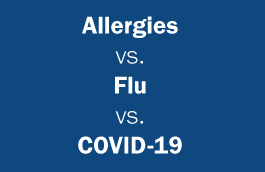
How to tell the difference and precautions to protect the workplace
| Allergies |
Flu |
COVID-19 |
| Sneezing |
Fever |
Fever 100.4F and over |
| Itchy Eyes or Nose |
Cough |
Cough |
| Runny or Stuffy Nose |
Sore Throat |
Shortness of Breath |
| Watery, Red or Swollen Eyes |
Runny or Stuffy Nose |
Phlegm Production |
| Shortness of Breath |
Muscle Pain or Body Aches |
Fatigue |
| Wheezing |
Headache |
Sore Throat |
| Cough |
Fatigue |
Headache |
| Rash or Hives |
- |
Muscle or Joint Pain |
| Nausea or Vomiting |
- |
Chills |
| Dry/Red/Cracked Skin |
- |
Nausea or Vomiting |
| - |
- |
Nasal Congestion |
Take precautions to protect yourself
Viruses spread in a number of ways including person-to-person contact, contaminated surfaces and poor hygiene. The Centers for Disease Control & Prevention (CDC) recommends taking the following steps to reduce your risk of contracting viruses, including COVID-19:
- Avoid close contact with people who are sick (staying six feet away or more is recommended).
- Avoid touching your face – nose, eyes, etc.
- Wash your hands often with soap and water – for at least 20 seconds – before eating, and especially after blowing your nose, coughing, sneezing or having been in a public place.
- If soap and water are not available, use a hand sanitizer that contains at least 60% alcohol.
- To the extent possible, avoid touching things – elevator buttons, door handles, handrails, etc. – in public places. Use a tissue or your sleeve to cover your hand or finger if you must touch something.
- Clean and disinfect your home and workplace to remove germs. Wipe down frequently touched surfaces, including tablets, electronic logging devices, scanners, cell phones, GPS screens, microwaves, doorknobs, light switches, handles, toilets, faucets and sinks.
- Avoid crowds and keep distance from others, especially in poorly ventilated spaces.
- Avoid non-essential travel, including plane trips and cruises.
A printable flyer is available from the CDC here.
Categorized in:
-
Transportation Safety
-
Injury Prevention
-
Driving Techniques
ClickToAddCategories
No categories have been created yet.
Community
Company Updates
Driver Recruitment
Investor News
Transportation Safety
Claims
Driver Management
Driving Techniques
Distracted Driving
Seasonal Driving Tips
Sharing the Road
Health & Wellness
Injury Prevention
Regulations
Security & Cargo Theft
Vehicle Inspections
Weather Conditions
Workplace Safety
Workers Compensation
Done